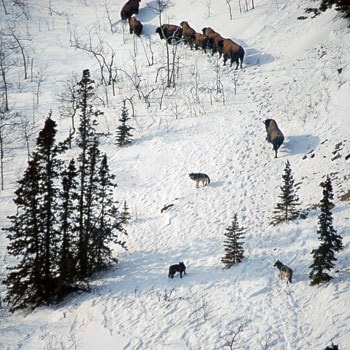The Yukon government is trying to figure out how to best manage the territory’s bison herd.
One of the big questions posed by the draft management plan, currently out for public comment, is how many bison should be allowed to roam the territory.
Wildlife managers are wondering whether the effort to reintroduce the species to the territory, started in the 1980s, has perhaps become too successful.
The latest estimates put the number of Yukon bison at 1,230. That’s more than double the territory’s current population target of 500.
It’s been suggested the target could be doubled to 1,000. That would help a national plan, which calls for a certain number of bison populations to be at least that size to ensure genetic diversity for the species.
But the reintroduction of bison - which disappeared from the territory early in the 20th century - hasn’t been popular with everyone. Some First Nations worry that bison are displacing moose and other animals favoured by hunters, because they are gobbling up long grasses and sedges.
In recent years hunters have had a more difficult time bagging bison. Once easy to approach by snowmobile, the animals now run when they hear the whine of the engines.
Wolves may eventually pick up some the slack. Conservation officers in Haines Junction received three reports of wolves preying on bison in the past year. The government received its first confirmed report of wolves killing a bison in 2007.
Last year two Yukon biologists, who were conducting an aerial survey, watched as wolves attacked an adult female bison. It was an unusual sight because wolves usually prefer to pick off the young or elderly rather than healthy adults.
Bison are considered a dangerous nuisance near Yukon’s highways. The animals usually keep their heads down so drivers don’t often see any telltale reflection of headlights off their eyes.
But since creating a special hunting zone for bison along the Alaska and North Klondike Highway, automobile collisions with bison have declined and few of the animals now venture near major roadways.
The Yukon’s bison are also supposed to be kept away from the Alaska and B.C. borders. It’s hoped that the Yukon’s herds will remain free of disease and genetically pure.
So far this season, hunters have killed 28 bison as of Dec. 30.
“It’s about average,” said conservation officer Ken Knutson. Of the animals taken, 13 were cows. The Environment Department would like to see more cows taken to help curb the bison population.
Most bison hunting occurs in the spring when longer days offer more opportunities for hunters.
There’s a ban on hunting bison from now until Feb.15. The six-week closure is meant to give the animals a break during the coldest time of year when they need energy the most.
Yukoners have until Jan. 20 to comment on the draft management plan. It’s posted on the Yukon Fish and Wildlife Management Board’s website.
The board meets next in February, but it may not deal with the bison plan until April, said executive director Graham Van Tighem.
Contact John Thompson at
johnt@yukon-news.com
